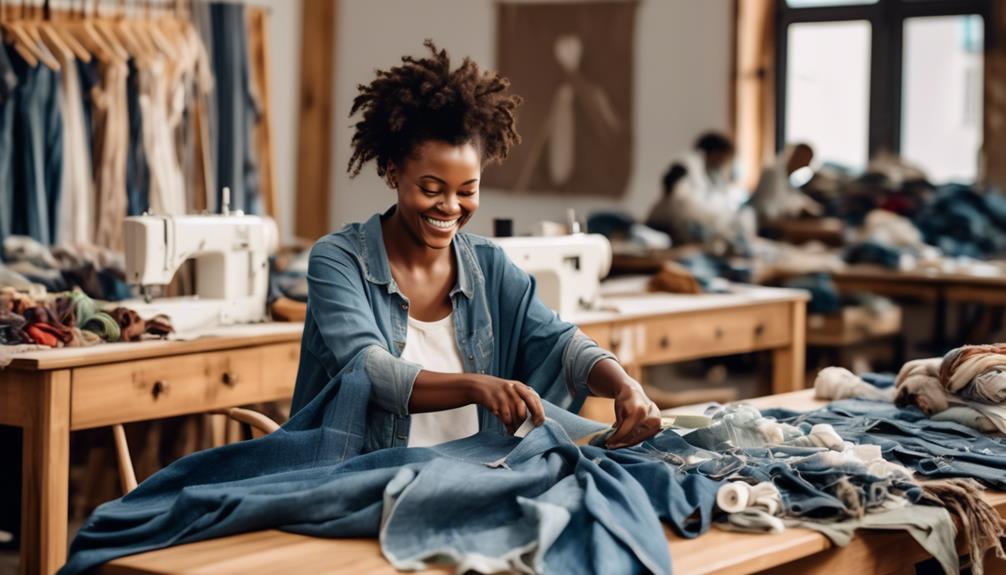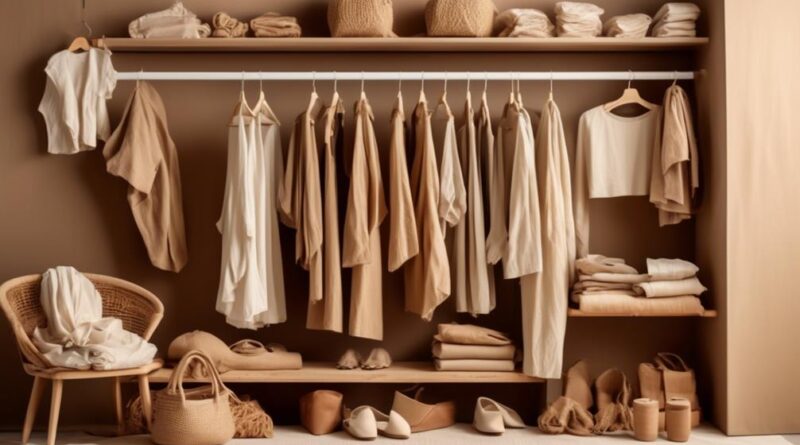Zero Waste Fashion: Sustainable Choices for Eco-Friendly Living
When it comes to fashion, you want to look good without sacrificing your commitment to sustainability. You may have heard about the concept of zero waste fashion, but what does it really mean for your wardrobe?
How can you make eco-friendly choices without compromising your style? In this discussion, we'll explore the practical and stylish ways you can embrace zero waste fashion, from sustainable fabrics to DIY clothing projects, and everything in between.
Get ready to rethink your approach to fashion and discover how you can make a positive impact on the planet without sacrificing your personal style.
Sustainable Fabrics
When choosing sustainable fabrics for zero waste fashion, opt for materials that have minimal environmental impact and can be easily recycled or biodegraded. Eco-friendly fibers like organic cotton, hemp, and bamboo are excellent choices for sustainable fashion. These fibers are grown without the use of harmful pesticides and chemicals, making them safer for the environment and the workers involved in their production. Additionally, they're biodegradable, meaning they can naturally decompose without causing harm to the planet.
Biodegradable textiles, such as Tencel and Modal, are also great options for zero waste fashion. These textiles are made from renewable plant materials and produced using eco-friendly processes. They aren't only biodegradable but also have a significantly lower environmental impact compared to conventional synthetic fibers. When these textiles eventually reach the end of their life cycle, they can easily break down into natural elements, reducing the overall environmental footprint of the fashion industry.
When it comes to sustainable fabrics, it's essential to consider the entire life cycle of the material, from production to disposal. Choosing eco-friendly fibers and biodegradable textiles is a crucial step in promoting zero waste fashion. By selecting fabrics that are gentle on the environment and can return to the earth at the end of their use, you can actively contribute to reducing the environmental impact of the fashion industry.
Minimalist Wardrobe
To build a minimalist wardrobe that aligns with zero waste fashion principles, focus on selecting versatile and timeless clothing pieces that can be easily mixed and matched. When curating your collection, prioritize essential items that serve multiple purposes. Opt for classic silhouettes and neutral colors that can be effortlessly paired together to create various outfits.
Versatile pieces like a well-fitted blazer, tailored trousers, a little black dress, and a crisp white shirt are key components of a minimalist wardrobe. These items can transition seamlessly from day to night and from casual to formal occasions, reducing the need for excessive clothing.
Consider investing in high-quality, durable fabrics that will stand the test of time, reducing the frequency of replacements and minimizing waste. Seek out pieces made from sustainable materials such as organic cotton, linen, or recycled fibers. These choices not only contribute to a more eco-friendly wardrobe but also ensure longevity, aligning with the essence of minimalism.
Upcycled Fashion
Consider incorporating upcycled fashion into your wardrobe to embrace sustainability and creativity while reducing waste in the fashion industry. Upcycled fashion offers a unique and eco-friendly way to revamp your style while making a positive impact on the environment.
Here are some reasons why you should consider upcycled fashion:
- Creative Repurposing: Upcycled fashion involves transforming old or discarded materials into new and stylish clothing items. This process allows for creative and innovative designs that aren't only environmentally friendly but also one-of-a-kind.
- Eco-Friendly Designs: By choosing upcycled fashion, you're actively contributing to the reduction of textile waste and the conservation of resources. Embracing eco-friendly designs in your wardrobe can help minimize the environmental impact of the fashion industry.
- Unique Personal Style: Upcycled fashion pieces often carry a unique history and character, adding a distinct flair to your personal style. Each upcycled garment has its own story and can become a conversation starter, showcasing your commitment to sustainability.
- Supporting Sustainable Practices: Opting for upcycled fashion supports sustainable fashion practices and encourages the industry to prioritize circularity and waste reduction. By investing in upcycled pieces, you're promoting a more sustainable approach to fashion consumption.
- Reducing Carbon Footprint: Choosing upcycled fashion over newly manufactured clothing helps lower the carbon footprint associated with the production and transportation of new garments. By extending the life cycle of materials, you're actively participating in the fight against climate change.
Repair and Alteration
Transform your clothing through repair and alteration to extend their lifespan and reduce the environmental impact of the fashion industry.
Clothing maintenance plays a crucial role in sustainable fashion. By learning eco-friendly stitching techniques and simple sewing skills, you can repair minor damages such as loose seams, small holes, or missing buttons. This not only saves your clothing from ending up in landfills but also reduces the need to purchase new items, thus decreasing the overall carbon footprint.
Additionally, alteration allows you to revamp and personalize your wardrobe without buying new clothes. You can easily tailor oversized or ill-fitting garments to your size or style preference. This not only extends the lifespan of the clothing but also gives them a fresh, customized look, reducing the desire to constantly buy new trendy pieces.
Understanding basic clothing maintenance and repair techniques empowers you to take better care of your garments, promoting a more sustainable lifestyle. By investing a little time and effort into repairing and altering your clothing, you contribute to the reduction of textile waste and the conservation of resources.
Embracing repair and alteration not only benefits the environment but also adds a personal touch to your wardrobe, making your clothing truly unique.
Ethical Brands
When seeking ethical brands, prioritize transparency in their supply chain and commitment to environmentally and socially responsible practices. Look for brands that support fair trade and prioritize ethical labor practices. Here are a few key things to consider when looking for ethical brands:
- Transparency: Seek brands that openly share information about their supply chain, including their sourcing and production processes. Transparency is a key indicator of a brand's commitment to ethical practices.
- Fair Trade Certification: Look for brands that have fair trade certifications, ensuring that the workers involved in the production process are paid fair wages and work in safe conditions.
- Sustainable Materials: Choose brands that prioritize the use of sustainable and eco-friendly materials, such as organic cotton, recycled fabrics, and low-impact dyes. This helps reduce the environmental impact of the fashion industry.
- Ethical Labor Practices: Ensure that the brand you choose follows ethical labor practices, including fair wages, reasonable working hours, and safe working conditions for all employees involved in the production process.
- Community Involvement: Consider brands that are actively involved in community development and empowerment, supporting local artisans and communities through their production processes.
Secondhand Shopping
Making sustainable choices in fashion can also involve exploring the option of secondhand shopping for clothing and accessories. Embracing secondhand shopping not only helps reduce waste but also allows you to discover unique pieces with character. When thrifting, consider these thrifting tips to make the most out of your experience.
First, visit thrift stores in affluent neighborhoods as they often have a better selection of high-quality, gently used items. Additionally, keep an open mind and be prepared to dig through racks to find vintage finds that suit your style. Don't forget to check for any flaws or damages, and try on clothing whenever possible to ensure a proper fit.
Secondhand shopping offers the opportunity to uncover one-of-a-kind vintage finds that can add a distinctive touch to your wardrobe. From timeless accessories to classic pieces of clothing, thrift stores can be a treasure trove for those with an eye for unique fashion. With a bit of patience and a keen eye, you can come across well-preserved items from past eras that complement modern trends.
DIY Clothing Projects

Discover new ways to express your creativity and sustainability values through engaging in DIY clothing projects. Embracing a zero-waste lifestyle means finding innovative ways to repurpose and create new garments from existing materials. With the rise of sewing tutorials and clothing refashioning, there are numerous opportunities to breathe new life into old clothing or fabric scraps.
Here are some exciting ideas to inspire your next DIY clothing project:
- Upcycled Denim: Learn how to transform old denim jeans into stylish shorts, skirts, or bags through simple sewing tutorials.
- T-shirt Reconstruction: Explore techniques for turning oversized t-shirts into trendy crop tops, tank tops, or reusable tote bags.
- Patchwork Quilting: Discover the art of patchwork quilting to create unique, colorful quilts or statement jackets using fabric scraps.
- Embroidery Embellishments: Add a personal touch to plain garments by learning basic embroidery stitches to create intricate designs and patterns.
- Sustainable Accessories: Repurpose fabric remnants to craft accessories like scrunchies, headbands, or face masks, reducing textile waste.
Capsule Collections
To curate a sustainable wardrobe that aligns with your values, consider embracing the concept of capsule collections, focusing on versatile, timeless pieces that can be mixed and matched for various occasions. A capsule collection typically consists of a limited number of essential clothing items that can be worn in multiple ways, allowing you to create numerous outfits from just a few key pieces. By investing in high-quality, versatile garments, you can significantly reduce your environmental impact while still maintaining a stylish and functional wardrobe.
When building a capsule collection, prioritize pieces that can seamlessly transition from day to night and from casual to formal settings. Look for items such as a classic white button-up shirt, a well-tailored blazer, a little black dress, a pair of tailored trousers, and a versatile coat. These timeless essentials serve as the foundation of your wardrobe, offering endless opportunities to mix and match different combinations for various occasions.
Opt for neutral colors and simple patterns to ensure that each piece can be effortlessly paired with others in your collection. This strategy allows for maximum versatility and ensures that every item serves a purpose, eliminating the need for excessive clothing consumption. Additionally, choosing high-quality, durable fabrics will prolong the lifespan of your garments, further reducing waste and promoting a more sustainable approach to fashion.
Frequently Asked Questions
Can Zero Waste Fashion Be Affordable for People on a Budget?
Yes, zero waste fashion can be affordable for people on a budget. You can find affordable options by exploring DIY alternatives, upcycling clothes, and shopping at thrift stores. Embracing creativity and resourcefulness can make sustainable fashion accessible to everyone.
How Can I Incorporate Zero Waste Fashion Into My Professional Wardrobe?
To incorporate zero waste fashion into your professional wardrobe, focus on eco-friendly workwear and sustainable office attire. Choose timeless, high-quality pieces, support ethical brands, and consider second-hand options. Embrace minimalism and versatility to create a stylish, sustainable look.
Are There Any Zero Waste Fashion Options for Children's Clothing?
Yes, there are eco-friendly materials and sustainable designs available for children's clothing. You can find options made from organic cotton, hemp, and recycled materials, as well as innovative designs that minimize waste in production.
Can Zero Waste Fashion Be Stylish and On-Trend?
Yes, zero waste fashion can be stylish and on-trend. Embracing sustainability doesn't mean sacrificing style. By choosing zero waste options, you can stay fashionable while making eco-friendly choices. Incorporating sustainability into fashion trends is possible and important.
What Are Some Creative Ways to Repurpose Old Clothing Into New Zero Waste Fashion Pieces?
To repurpose old clothing into new zero waste fashion pieces, try upcycling techniques like turning old jeans into a trendy denim skirt or creating DIY projects such as transforming a t-shirt into a stylish tote bag.
Conclusion
In conclusion, zero waste fashion is all about making sustainable choices for an eco-friendly lifestyle. By choosing sustainable fabrics, creating a minimalist wardrobe, upcycling and repairing clothing, supporting ethical brands, and embracing secondhand shopping and DIY projects, you can make a positive impact on the environment.
Consider adopting a zero waste approach to fashion and make a difference in the world.
